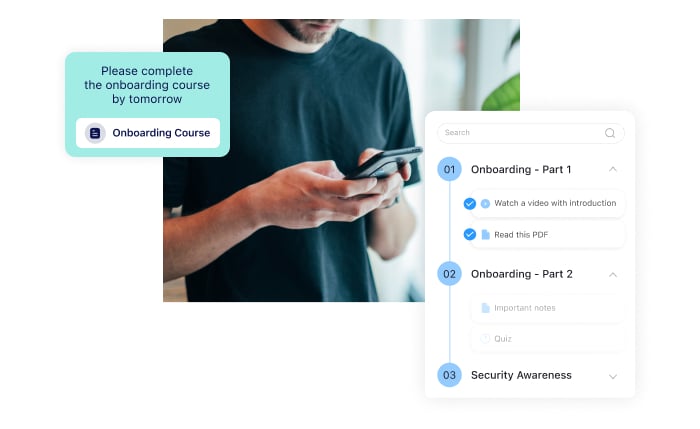Effective new employee training is crucial to the success of your business. Learn how and why investing in comprehensive training programs can enhance productivity, engagement, and business growth.
Companies need to do everything in their power to support new employees in their transition to a new company.
Training new employees helps new hires quickly understand their roles, align with company culture and values, and build good working relationships with coworkers. This helps employees feel comfortable in a new environment. Importantly, it also provides employees with the skills and confidence they need to start contributing to company goals as soon as possible.
Despite this, Gallup reports that only 12% of new employees feel their company has effective onboarding. The majority of new recruits are left to fend for themselves, laying the path for failure and early exits. This is often because business leaders either don’t follow trends in employee engagement, don’t know how to support new hires or don’t prioritize it.
In this article, we look at 8 effective tips for training new employees so you can create a robust onboarding and training program to set your latest team members up for success.
Identify Training Needs and Prepare Onboarding Resources
If you want to know how to train new employees, it all starts with identifying what it’ll take for employees to be successful in their roles. You can do this by evaluating your business goals, speaking to the hiring manager, and reviewing industry standards.
Further, try to understand employees’ knowledge levels before they join the company. You can identify new employee training needs through online surveys or practical assessments and conduct practical assessments in person or through video chat.
From there, you can customize training materials to address key skills gaps instead of wasting time teaching new joiners what they already know. In fact, 91% of respondents in a recent survey said they’d want a training plan that’s personalized and relevant.
You can also consider offering pre-onboarding resources or reading materials for new hires to complete before their first day of work. This is a good way of ensuring that workers enter their new roles with sufficient knowledge.
For example, a new property manager may be asked to read reports about the local real estate market before they start their new job. This will help to minimize the lag time between their joining and making active contributions to company goals.
Finally, you should have a comprehensive onboarding process that you can refer to before, during, and after onboarding to ensure that you’ve covered all the bases.
🧠 Did You Know?
A Harvard report found that companies with formal onboarding programs could see 50% better retention and 62% greater productivity among new hires.
Create and Provide Clear SOPs
A standard operating procedure (SOP) is a written document with step-by-step instructions on how to perform particular tasks or job duties. Make sure each role in your company has clear SOPs for their designated tasks. Then, you can incorporate these documents as part of new employee training to teach new hires the ropes.
A solid SOP will be clear, concise, and easy to understand. It should cover all the information new workers need to complete a task, including any safety precautions they need to take. Ideally, subject matter experts (SMEs), supervisors, or experienced employees will review the SOP to ensure it’s complete and accurate.
Overall, utilizing SOPs in your new employee training and onboarding process can help new hires learn how to perform tasks quickly and consistently, reduce errors, and improve productivity on your team.
💡 Pro Tip:
Provide new employees with easy access to the SOPs they need to perform their jobs. Connecteam’s dedicated employee training app includes an online knowledge base that automatically syncs between all of your employees to make sure everyone works off of the same updated standards.
You can explore our guide to the best SOP software to streamline access to standard operating procedures, protocols, and policies, ensuring your team always has essential information at their fingertips.
You might want to read our in-depth review of the best employee onboarding apps to help you decide on the right app for your needs.
Provide Easy Access to Training Materials
Effective new-hire training programs make it easy for employees to access training materials. You should have all employee training programs accessible from one central location. This makes it simple for new employees to know where to go for training courses, SOPs, FAQs, and more—saving everyone a ton of time.
It also allows existing employees to easily reference any materials they need to refresh their memory on a particular topic. Everyone receives and uses the same information on the job, establishing consistency in work and reducing errors and misunderstandings.

Centrally storing training courses and media files in an online knowledge base also helps you stay organized. You can categorize materials by topic, keep files updated, and delete any outdated documents.
New hires should also have the ability to access all their training courses and materials from anywhere. Most of today’s workforce comprises Millennials and Gen Z employees. Research states that 90% of Millennials and 98% of Gen Z workers use smartphones, so mobile-friendly new employee training is essential.
Employee training software like Connecteam allows you to easily create and deliver training materials, including videos, quizzes, and documents, as well as track employee progress and automate training workflows to save time and increase productivity.
What’s more, Connecteam has a user-friendly and intuitive mobile app that employees can use to access content on the go.
Sign up for a free 14-day trial to see how you can make employee training a breeze.
💡 Pro Tip:
When creating training courses, be sure to structure the material in brief sections that are easy to understand, a teaching method known as microtraining. This training method presents new training topics in short modules, using a variety of formats. For example, you could present a 5-minute online training video followed by a quick quiz on the topic, instead of a long, drawn-out training session.
Why is microtraining so effective? Because it presents new information in bite-sized chunks, resulting in more engaging and effective training compared to more time-consuming delivery methods. It prevents employees from becoming bored and leads to higher knowledge retention than traditional methods.
Build a Formal Training Curriculum
When you think about how to train a new employee, you need to first establish what you want to train them on. Good employee training programs account for both the organization’s goals and the new hire’s roles and responsibilities.
When training a new hire, create a curriculum that includes the following topics:
- Induction training: Provides an overview of the company’s mission, culture, benefits, and departments. This training will also lay down what the employee’s roles and responsibilities are, as well as job expectations for the first few weeks. In certain roles, this will also include giving the employee a tour of their job site and introducing them to colleagues and customers.
- Compliance training: Details important legal and compliance requirements such as workplace safety, data privacy, anti-harassment, and reporting violations. Having new hires read your organization’s employee handbook is a great step in compliance training.
- Skills training: Helps employees brush up on the skills they require for their specific roles. This can include good customer service, effective communication, or other technical skills.
- Product or service training: Provides employees with key knowledge of a company’s products or services. The purpose is to equip workers with the knowledge and skills they need to understand, use, promote, and sell products or services effectively.
- Manager training: For new hires joining as managers or in a leadership role, consider providing training on skills like team building, project management, and conflict resolution. In fact, you may want to roll this out more extensively—a recent study showed that 60% of Millennials want leadership training.
Keep in mind that you need to create training courses that are clear, concise, and that follows an order of information that builds upon itself. This helps reiterate important ideas throughout the training process, ensures a certain level of consistency in training between new employees, makes for more efficient and effective learning, and is associated with better learning outcomes.
Moreover, a new hire trainer program can follow a blended learning approach. This means they have components of online and offline learning. In the next two sections, we take a closer look at these learning options.
💡 Pro Tip:
Check out this article during the interview process to better understand the qualities of a good employee so help you keep an eye out for what to look for in potential new team members.
Use Technology to Create Courses, Test Learning, and Track Progress
When you’re creating a plan for training new employees, using the power of technology and software is a must. The below list covers the key things you can do with training software.
Create and roll out courses
Training software provides tools and features that simplify the process of creating and publishing training content.
They generally have a user-friendly interface, making it easy even for non-technical managers to create courses. You can also use pre-built templates as a starting point and customize from there to save time and effort.
The best employee training software will let you add multimedia content such as images, videos, and audio to make learning more effective and engaging.
Digital training allows new employees to access their courses from anywhere using their desktop or mobile devices. A recent statistic showed that 44% of respondents used their mobile phones to complete job training. This is only going to grow with the rise of tech-savvy Gen Z employees, so companies need to adapt.

Connecteam is the best all-in-one training and employee engagement solution. It includes simple course creation, options for testing learning, a comprehensive dashboard to track employee training progress, and a full suite of in-app communication tools.
Get started with Connecteam for free to fast-track your new employee training.
Test learning
Interactive features are a great way to test employee understanding of training content.
Use quizzes to test employees’ knowledge after each training module and implement gaming elements, like points and digital badges, to reward them for passing.You can also take advantage of surveys to gather feed from your new employees so you can learn what to change in your training program or improve upon.
Track progress
Training apps offer a simple way to assign deadlines for completing courses and tracking progress. New hires have a lot to learn in a short span of time, so it’s important to have an easy, reliable way to check that they’re on the right track and offer them support if they’re struggling to complete their programs.Connecteam, for example, has an easy-to-read admin dashboard. Here, you can track new employee training progress and check in with your new hires if they aren’t doing well on training quizzes.
📚 This Might Interest You:
Streamline your training process and ensure every team member stays up to date. Our guide to the best employee training tracking software shows you how to track progress, manage certifications, and build a well-trained team ready to take on new challenges.
Communicate effectively
Honest and timely communication is essential part of training for new employees. Employee training software should include communication features such as in-app chat, discussion groups, and feedback surveys. These features can help learners to engage with instructors and peers, clarify concepts, and provide real-time feedback on their progress.
Encourage Shadowing and On-the-Job Learning
When training new employees, offer some practical, hands-on skills development when possible.
Job shadowing allows new hires to spend time with a more experienced coworker and see the day-to-day operations of their role. New workers can learn by observing, making notes, and asking questions to gain a deeper understanding of a role.
You should also encourage your employees to interact with coworkers from other departments or engage in cross-functional shadowing. This is a great way to understand how different teams work and learn more about how to build company culture and your organization’s overall goals.
Another powerful learning tool is on-the-job learning. Training statistics show that 82% of employees consider on-the-job training the most effective way to learn. You can assign real-life tasks to new hires and support them as they complete each one.
Assign a Mentor or Buddy for Additional Support
New hires can greatly benefit from having an assigned mentor or buddy to provide them with additional support during the onboarding process. According to an HCI report, 87% of companies with a mentor or buddy program found it to be effective in training new employees.
A mentor is a senior member of staff who can help an employee navigate their role. They can also offer advice on sensitive issues such as team conflicts or if the employee is struggling to settle into the new company culture.
Meanwhile, a buddy is more of a friendly coworker who can offer peer-to-peer support and job shadowing. Plus, they can answer any questions that the employee doesn’t feel comfortable asking their manager or mentor.
Where employees are scattered across different locations, team chats, and video calls facilitate quick and easy communication between new hires and their mentors or buddies.
You should also think about how to train new employee mentors and buddies so they know what to do and what not to do during new hires’ sensitive and overwhelming first few weeks at work.
Provide and Receive Regular Feedback
New employees need to be given regular, timely feedback so they can improve their performance on the job as quickly as possible. Feedback can really help employees understand what they’re doing right and wrong so they can adapt and improve going forward.
Additionally, it’s critical that managers understand the importance of being supportive and patient with their new recruits. This means providing them with the necessary resources, offering encouragement and feedback, and providing opportunities for practice and application of the new skills or knowledge.
Check-ins and onboarding surveys are a good way for new hires to share their feedback with you. You can address any questions or concerns they have and also fine-tune your training strategy to incorporate new ideas and suggestions.
Summary
Early experiences can make or break new hires’ feelings, performance, and sense of belonging in a new company. A Harvard report found that companies with a formal onboarding program could see 50% better retention and 62% greater productivity among new hires.
It’s essential to create a training program that works for your team and your business. Training new employees with a blended approach of online and on-the-job learning is an excellent way to bring them up to speed on their roles and responsibilities. Moreover, assigning a mentor or buddy to provide them with additional support can help them feel more comfortable with the culture and gain valuable insights into navigating their new jobs.
Additionally, check in with new employees regularly so you can provide them with feedback on their performance. You should also gather feedback and suggestions from new hires so you can further adjust and improve the employee onboarding experience at your company.
Connecteam’s employee training software provides a comprehensive solution for businesses to create, deliver, and manage their training programs.
With the ability to design customized training content, including videos, quizzes, and documents, businesses can ensure their employees receive the specific training they need to perform their jobs effectively.
Connecteam’s software also includes features for tracking employee progress and engagement, enabling businesses to monitor the effectiveness of their training programs and make adjustments as needed.




